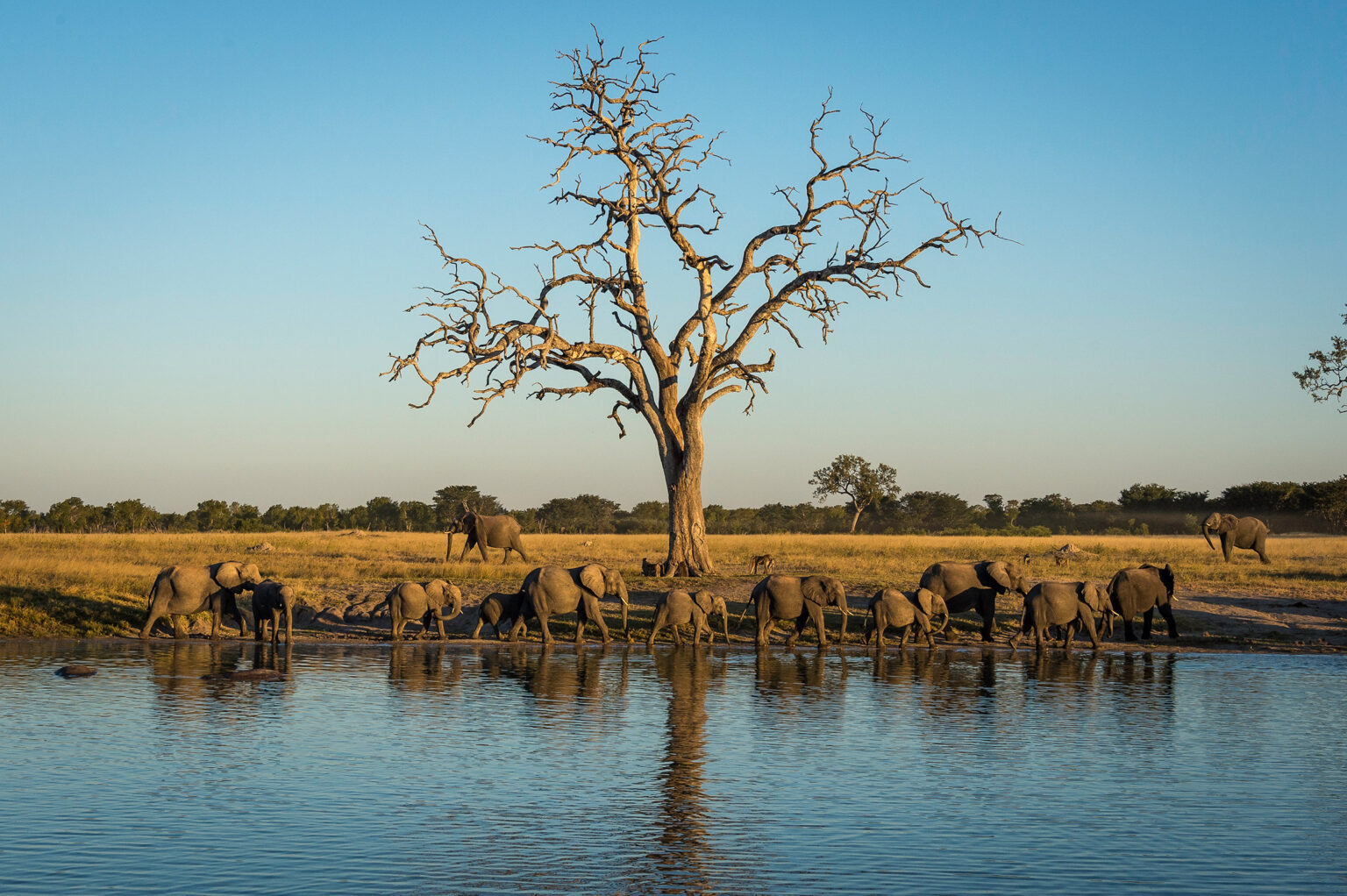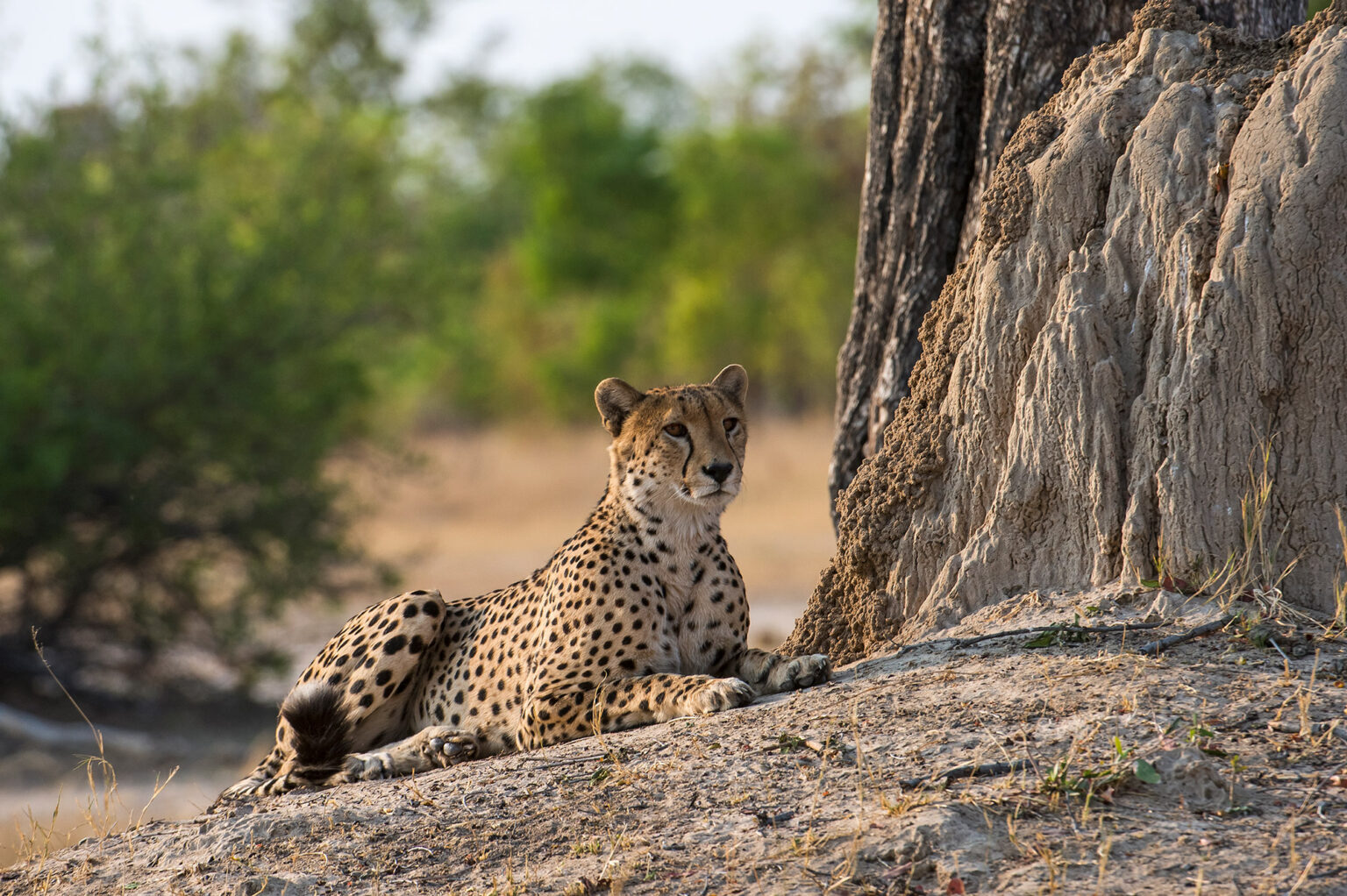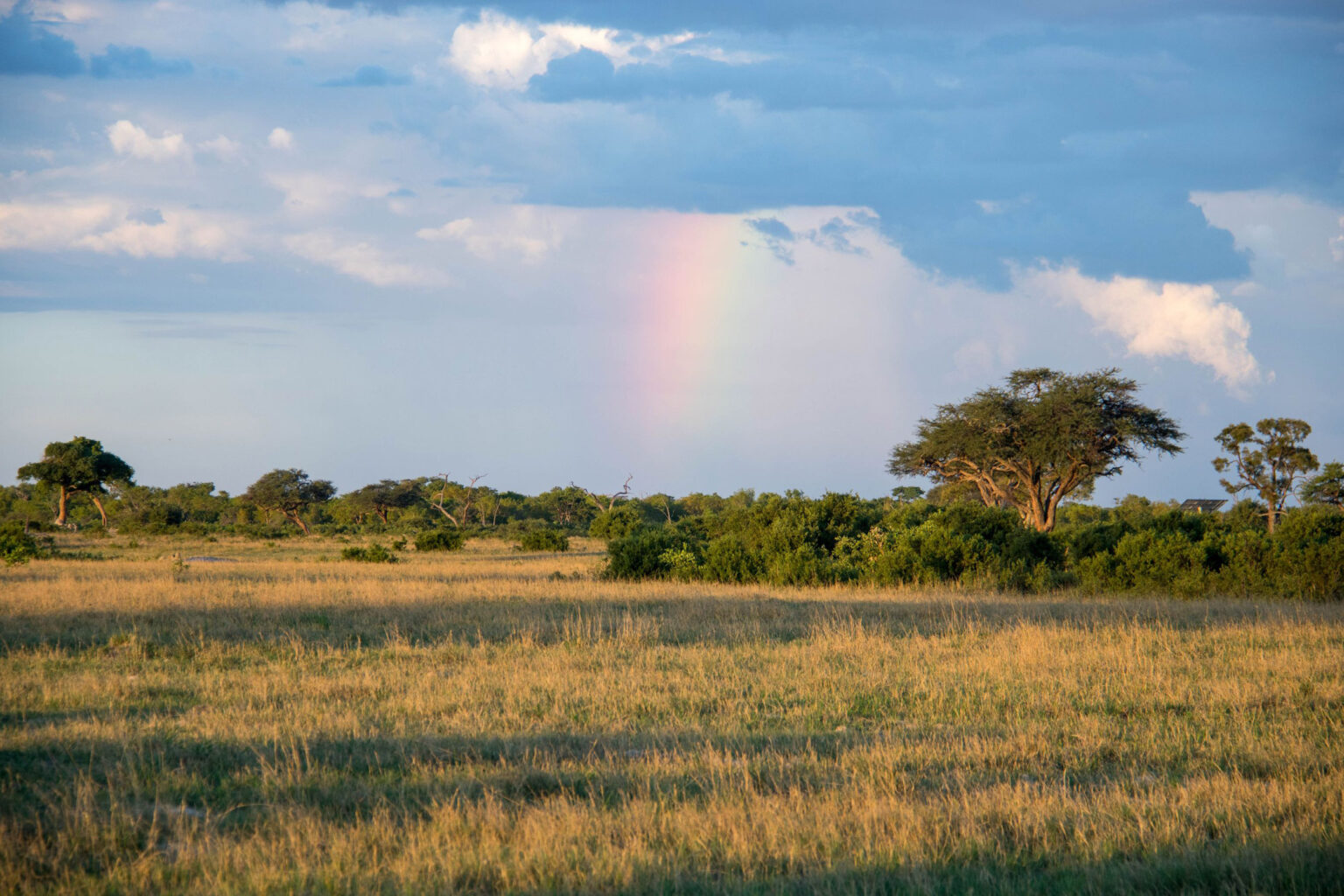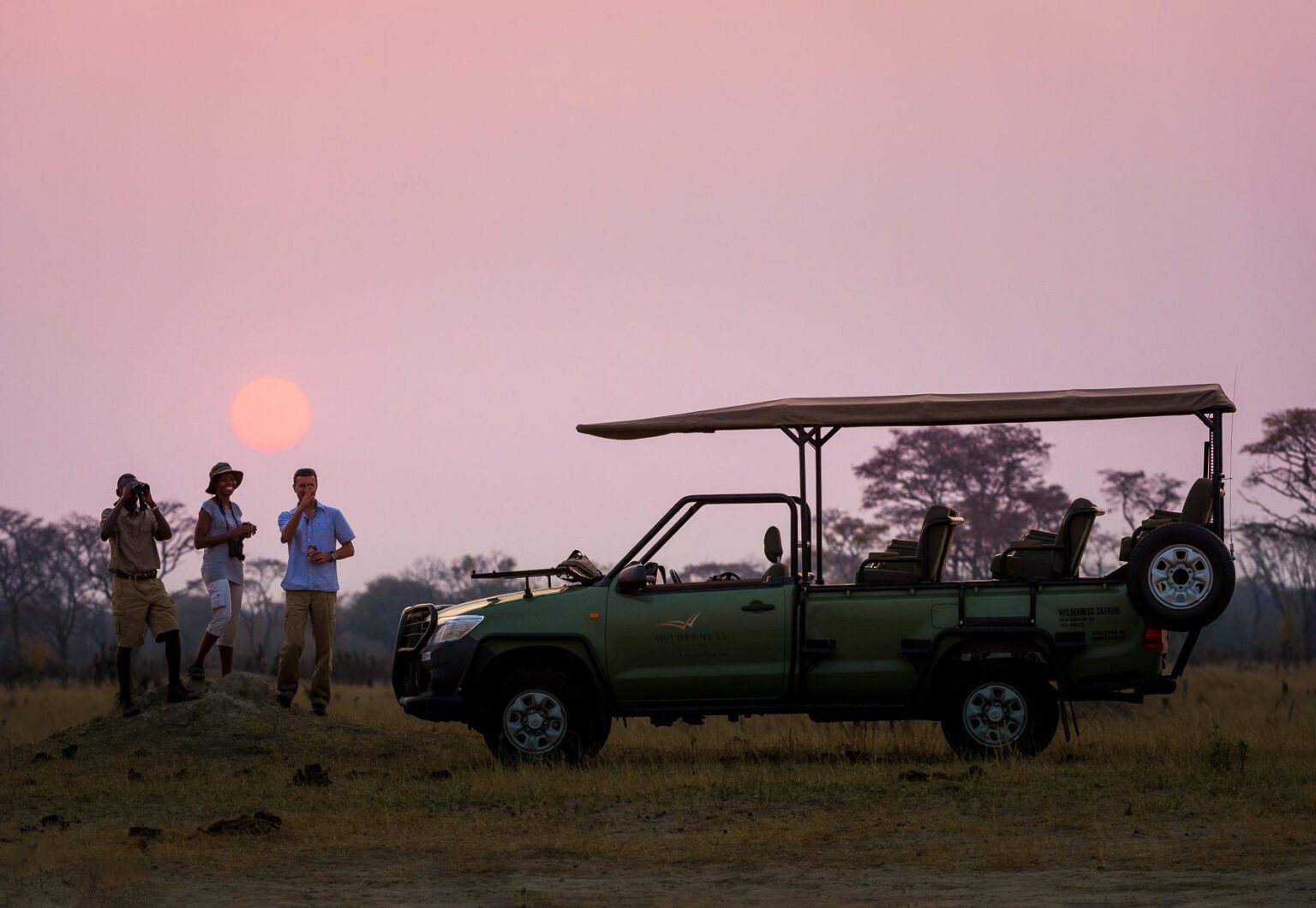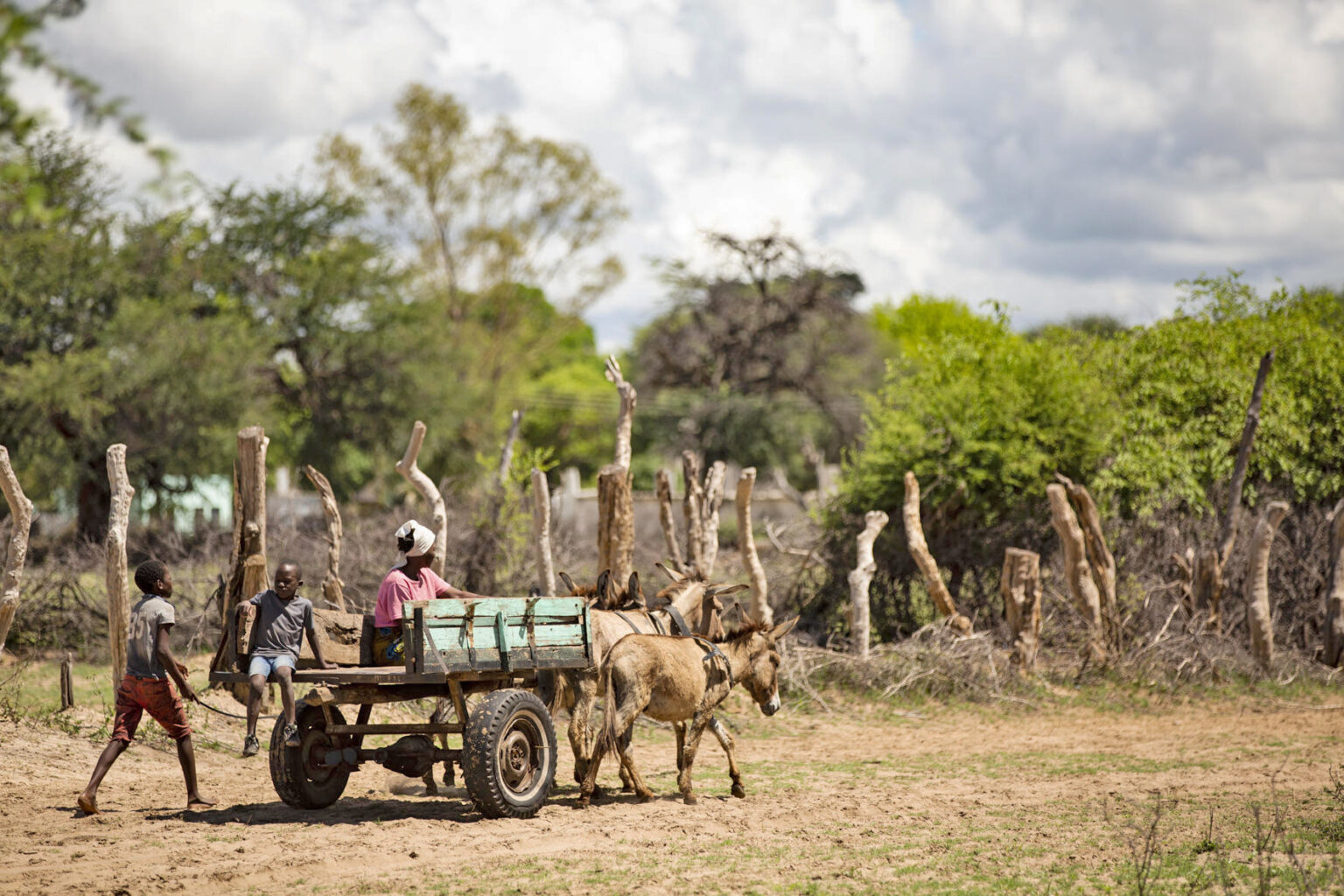Hwange National Park
At the lip of a crowded waterhole, a parade of elephants mingles with a zeal of zebra. Giraffe tower overhead, steadying their lanky legs before stretching way down for a long sip. Predators slink closer for a drink, and with luck, an easy meal.
It’s dry season in Hwange, Zimbabwe’s largest and oldest national park, and finding water is vexing thirsty resident wildlife. Uniquely, there are no permanent water sources in the park, leading animals to congregate in dizzying numbers at pumped boreholes.
Back at camp, elephants stand shoulder-to-shoulder at a pool—shockingly close to guests seated on a terrace—snaking their trunks into the water for a greedy gulp.
Up-close elephant encounters and throngs of wildlife at the waterhole are just two portraits of what makes Hwange so special. In this guide, we will deep dive into the incredible tented camps, unique activities, and the logistics of a Hwange National Park luxury safari.
What is Hwange National Park known for?
Hwange National Park is notable for both its size and legacy. Established in 1930, it spans 5,657 square miles (comparable to the size of Connecticut) with a hilly north and open plains in the south.
This vast park harbors an array and density of wildlife, but its staggering elephant population gives it a reputation as an elephant stronghold.
Compared to famous parks and reserves like Greater Kruger (South Africa), Chobe (Botswana), Serengeti (Tanzania), and the Maasai Mara (Kenya), we love Hwange for its relative lack of crowds—unless you count elephants queuing at your pool a crowd. Additionally, Hwange—Zimbabwe, really—offers strong value for your safari dollar.
Contained within Hwange are several private concessions, where many of the best luxury safari lodges in Zimbabwe are located. Staying in a concession means you can enjoy some of the activities that are otherwise prohibited on national park land: bush walks, walking safaris, and night/sunset game drives. You’re also assured a more exclusive safari experience because no outside game vehicles can traverse the concession.
Where is Hwange National Park?
Situated in western Zimbabwe and bordering Botswana, Hwange National Park lies just 75 miles south of Victoria Falls. The park lies along the ancient migration route connecting it with modern-day Chobe National Park and the Linyanti area in Botswana. An Extraordinary Journeys luxury Zimbabwe safari itinerary almost always includes a stop at Hwange National Park.
Hwange National Park history and conservation
Hwange was established as a game reserve in 1928 before being designated a national park two years later.
Unfortunately, the park has a dark history of poaching, which is being jointly addressed by a partnership between government agencies, conservation organizations, NGOs, and local communities. Many camps and lodges also undertake conservation projects.
Despite the presence of the Big Five, when it comes to rhino, there are so few that their inclusion is a fragile technicality. In 1985, some 100 white rhino were counted in Hwange. In 2007, the last remaining one was poached. In 2023, the Community Rhino Conservation Initiative reintroduced a pair of rhino with the ambitious goal of (eventually) establishing a viable population.Hwange National Park is also part of the Kavango-Zambezi Transfrontier Conservation Area, one of the world’s largest conservation areas which promotes cross-border cooperation with neighboring Angola, Botswana, Namibia, and Zambia. In a combined effort, the partners work toward the conservation of biodiversity, the protection of wildlife corridors, and the development and promotion of sustainable tourism.
Animals in Hwange National Park
Hwange National Park is home to most of the Big Five (lion, leopard, rhino, elephant, and African buffalo), and you’re likely to see giraffe, impala, hippo, zebra, wildebeest, wild dog, and countless species of birds.
- Elephants are, no doubt, the stars of Hwange National Park. At least half of Zimbabwe’s elephants live within park boundaries, including a super-herd of about 450.
- Endangered wild dogs, also known as painted dogs, are estimated to number around 160. Compared with the elephant population, this might seem like a small number, but with only a total of about 7,000 in all of Africa, this is a great place to see them.
- Cheetahs, the fastest land animal, are capable of running at speeds of 60-70 miles per hour. And, while it’s difficult to estimate how many call Hwange their home, it’s known as one of the prime locations in Zimbabwe to encounter them.
- Hwange is well-known for its healthy lion population. With somewhere between 500-700 lions roaming the park, Hwange has played a significant role in the species’ conservation.
- Various types of hyenas roam throughout Hwange, including the rare brown hyena.
- With more than 400 species of birds, including a large number of raptors, birders won’t be disappointed. There’s a good chance to spot the kori bustard, African gray hornbill, and the colorful African paradise flycatcher.
Which are the best months to visit Hwange National Park?
Hwange National Park is one of few places in southern Africa that is truly a year-round destination. As in, secret season (“green” or “wet” season) is arguably as appealing as the dry season.
Classically, July through late October/early November are the dry months. During this time, wildlife congregates en masse at pumped waterholes. Thin foliage and shorter grasses mean less camouflage for wildlife, and, consequently, easier game spotting for safari-goers.
Secret season (“green season”) usually starts in November and stretches to about April. October is the hottest month, with an average temperature of 94°F, but often stretching above 100°F. If you can stand the daytime heat, the wildlife viewing in October can’t be beat.
Once the rain starts, grasses are long and high, and tree canopies burst into greens. On the Ngomo Plains, grazers arrive to birth their newborns while predators keep watch. If rain falls, it comes in the form of a moody morning or afternoon shower which might stop as abruptly as it started, and clears the skies.
The best safaris in Hwange National Park
With its size and diverse landscapes, Hwange offers visitors a variety of safari experiences, and not all of them take place in a Land Cruiser.
Game drives in Hwange are special thanks to the variety and volume of wildlife found in the park. Zimbabwe’s rigorous guide training ensures a high-caliber experience. A luxury Hwange safari will include an early morning and an afternoon game drive.
Night game drives layer the thrill of a daylight safari with the riddle of darkness. Track predators at work and listen to the evening chorus of nocturnal critters. *Night game drives are limited to guests staying in a private concession.
Walking safaris* and bush walks are a completely different experience from a game vehicle safari. Viewing wildlife on foot (from a safe distance) means bringing the smaller critters that you’d otherwise zoom by into greater focus. Immediately, your primordial instincts will kick in, picking up the slightest sounds, smells, and movements. It’s both humbling and thrilling.
*Walking safaris are limited to guests staying in a private concession.
Chug along the eastern edge of Hwange on the Elephant Express, a unique safari experience for everybody, but especially for young safari-goers. Get up, walk around, and enjoy a cocktail, all while gazing upon the vast, wildlife-dotted plains. The route stretches 50 miles and connects north and south Hwange, making it a practical and scenic rail transfer between the two parts.
Female-guided safaris: Female guides are few and far between in the safari world, which makes participating in a Women Empowerment Safari so special. You’ll experience safari from a whole new viewpoint while further supporting the program that continues to train female guides.
Community visits: Visiting a local community contextualizes a safari experience in so many ways. You’ll meet the people who call this land home, and learn about traditions, culture, and customs. It also brings the challenges of living alongside big game and wildlife into focus. Many lodges support conservation efforts and work in partnership with local communities, contributing to projects like education, healthcare, maternal care, and employment. (This lodge even runs a Learner Impact Safari, which spends three nights in Hwange.) You’ll learn how your visit positively impacts people and place.
Where to stay in Hwange National Park
Many of the best luxury safari camps in Hwange National Park are located in the southeast on private concessions. Extraordinary Journeys safari specialists recommend private concessions for their exclusivity, uncrowded game drives, and activities that can’t otherwise be done on national park land.
The best Hwange National Park accommodation is:
- Somalisa: This Hwange accommodation is an intimate, seven-tent, vintage-style camp set beneath a grove of acacia trees and next to a seasonal flood plain. Its reputation for up-close elephant encounters comes courtesy of the small pool on the edge of the camp that serves as a watering hole for these glorious creatures.
- Linkwasha Camp: Linkwasha’s nine oversized tented suites take refuge in the shade of leadwood trees, and boast patio views of elephants gathering at a nearby waterhole. By day, spy on wildlife from the sunken blind, luxuriate in a poolside cabana, and explore the 34,000-acre Linkwasha-Makololo Private Wilderness Area during twice-daily game drives or bush walks. Doze off in a star bed while listening to a song of hooting owls and whooping hyenas.-
- Little Makalolo Camp: This intimate property offers high-quality service delivered with the warmth of a first-name basis. Head out on a game drive where you’ll encounter vast numbers of wildlife, but few people. After a long day of adventure, enjoy an outdoor shower or a luxurious dip in the pool to watch the wildlife parade.
More luxury accommodations in Hwange National Park
How to get to Hwange National Park
It’s a 90-minute drive from Victoria Falls to Sinametella, Hwange’s northern main gate, and a two-and-a-half-hour drive to Hwange Main Camp in the south. Depending on which safari camp(s) you stay at, it may be another couple of hours beyond the park entrance. (Don’t worry, it’ll be a scenic drive!)
If you’re staying in the south, it might be practical to arrive via Bulawayo Airport and then take a ground transfer. Your Extraordinary Journeys Africa expert will coordinate the most seamless route.
Should you prefer to fly, it takes about 30 to 45 minutes to reach one of the park airstrips (Hwange Main, Manga, Bomani, and Linkwasha) from Victoria Falls Airport.
Hwange National Park FAQs
How long should I plan to spend in Hwange National Park?
You should spend at least three nights in Hwange National Park. The park is vast, and the terrain varies between the southern plains and hilly north, so it’s easy to spend four to six nights if you’ve got the time. Staying at complementary camps like Bomani or Camelthorn (north) and Jozibanini (south) is a great way to get two very different safari experiences without leaving Hwange.
Can I see the Big Five in Hwange National Park?
While the Big Five call Hwange home, there are very few rhinos.
Is Hwange National Park family-friendly?
Yes, Hwange is a great place to explore together. With kids in tow, we recommend a private vehicle and guide for the most flexible experience. Everyone will enjoy the Elephant Express train and restless kids will love being able to move around. Both Linkwasha and Little Makalolo offer a family suite.
Easy extensions
Hwange National Park is commonly paired with other safari destinations in Zimbabwe, Botswana (Linyanti and the Okavango Delta), and a visit to Victoria Falls.
For a nice contrast of landscapes and experiences, some travelers combine it with Kruger National Park (South Africa) via Victoria Falls.
Luxury safaris in Hwange National Park
Other areas to explore
Plan your Trip
Ready to start planning your own incredible adventure? We make the process stress-free and enjoyable.




